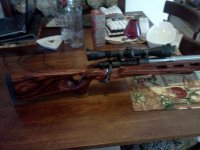Hi,
Thanks for letting me join this forum. I have been repairing, and refinishing rifle stocks as a hobby for over 10 years. As I was reading over previous posts I saw a couple questions that I can comment on.
1. Type of finish. Always use a oil-based finish such as Tung, or Boiled linseed oil because the others seal the wood to the point that down the road the wood will dry out, shrink and crack the finish, and I have even seen the wood itself crack. As the oil finish deteriorates, clean, scrub down with fine steel wool, and put more finish on.
2. Fixing "dings, and dents" is easy. When your wife is away from the house borrow her steam iron, set it to the highest heat with water in it to generate steam, and with a shop cloth between the iron and the wood "iron" the stock. You will amazed at the results.
To my project. I am replacing the plastic stock on my Remington 700 with a Extra fancy Claro walnut stock. The " Extra Fancy" means that the wood grain goes in at least 9,352 directions which makes it a pain to get rid of the sanding marks. Normally you sand with the grain but with this wood it is difficult to say the least. Has anyone out there had any experience with this? If so I would appreciate any feedback.
I also plan on floating the barrel, bedding the action, and pillar bedding it.
Thanks
Thanks for letting me join this forum. I have been repairing, and refinishing rifle stocks as a hobby for over 10 years. As I was reading over previous posts I saw a couple questions that I can comment on.
1. Type of finish. Always use a oil-based finish such as Tung, or Boiled linseed oil because the others seal the wood to the point that down the road the wood will dry out, shrink and crack the finish, and I have even seen the wood itself crack. As the oil finish deteriorates, clean, scrub down with fine steel wool, and put more finish on.
2. Fixing "dings, and dents" is easy. When your wife is away from the house borrow her steam iron, set it to the highest heat with water in it to generate steam, and with a shop cloth between the iron and the wood "iron" the stock. You will amazed at the results.
To my project. I am replacing the plastic stock on my Remington 700 with a Extra fancy Claro walnut stock. The " Extra Fancy" means that the wood grain goes in at least 9,352 directions which makes it a pain to get rid of the sanding marks. Normally you sand with the grain but with this wood it is difficult to say the least. Has anyone out there had any experience with this? If so I would appreciate any feedback.
I also plan on floating the barrel, bedding the action, and pillar bedding it.
Thanks

